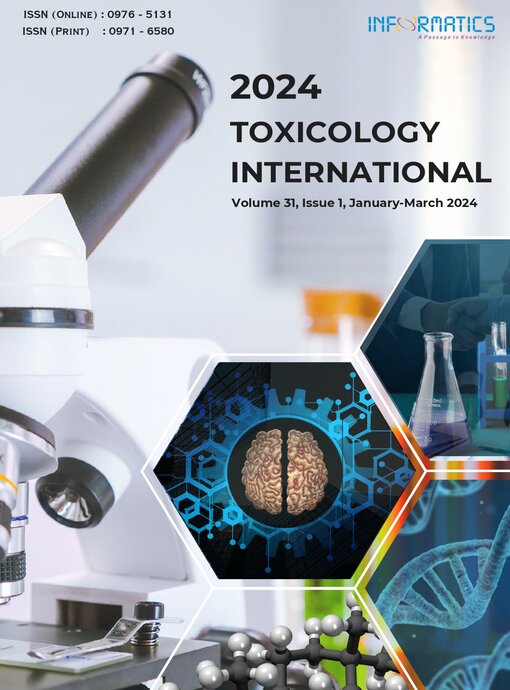Acute Toxicity Study of Hexane Extract of Sodhita Semecarpus anacardium L. Drupe in Wistar Albino Rats and its Prediction Using In-Silico Tool
DOI:
https://doi.org/10.18311/ti/2024/v31i1/35349Keywords:
GCMS, In-Silico, LD50, Semecarpus anacardium, Sodhana, ToxicityAbstract
Semecarpus anacardium L. belongs to the family Anacardiaceae. Its drupe is widely used in Ayurvedic formulations after sodhana processing as it is listed under Schedule E1 of the Drugs and Cosmetics Act 1940. In this study, sodhita Semecarpus anacardium L. drupe was extracted with n-hexane and the yield was found to be 56%. The extract was subjected to GCMS (Gas Chromatography Mass Spectrometry) analysis and its characteristics were studied using an in silico tool. Acute oral and dermal toxicity studies were performed on the Wistar albino rats as per the OECD 425 and 402 guidelines respectively. The GCMS data revealed the presence of C13H18O3 (m/z: 222.1) with an abundance of 93.63%. The compound was predicted as potentially hazardous with a probable mutagenic category of ICH M7 class 3. An oxirane functional group of the compound was predicted to cause potent irritation properties to the eyes and skin with positive scores of 0.76 and 0.57 respectively. The LD50 was found to be more than the limit dose of 2000mg/kg body weight upon oral administration. Acute dermal exposure at a limited dose of 2000mg/kg body weight did not cause mortality. However, inflammatory responses started appearing within 48 hours of exposure. Histopathology revealed mild dermal oedema, mild fibrosis, dilated follicles hyperplasia etc. No changes were found in haematological parameters. Inflammation and dermal allergic reactions were completely self-healed by the end of 14 days. The results suggest that the oil portion of the sodhita drupe possesses the irritant properties of the Semecarpus anacardium. It might be due to the presence of the compound C13H18O3 with Oxirane as a functional group.
Downloads
Published
How to Cite
Issue
Section
License
Copyright (c) 2024 P. Gopinath, R. Arunadevi

This work is licensed under a Creative Commons Attribution 4.0 International License.
Accepted 2023-11-17
Published 2024-02-28
References
Semalty M, Semalty A, Badola A, Joshi GK, Rawat MS. Semecarpus anacardium Linn.: A review. Phcog Rev. 2010; 4(7):88-94. https://doi.org/10.4103/0973-7847.65328 PMid: 22228947 PMCid: PMC3249908. DOI: https://doi.org/10.4103/0973-7847.65328
Ilanchezhian R, Roshy JC, Acharya R, Harisha CR, Shukla V. Pharmacognostical and Physicochemical Analysis of Bhallataka (Semecarpus anacardium Linn.) – Fruit. Phcog J. 2011; 3(20):9-16. https://doi.org/10.5530/pj.2011.20.3 DOI: https://doi.org/10.5530/pj.2011.20.3
Juliet L, Raja SK, Reena VL, Aarthi V, Kumar KNS, Sathiyarajeswaran P et al.,. Traditional methods of purification (detoxification process) for schedule E poisonous drugs. IJTK. 2021; 20(3):740-48. https://doi.org/10.56042/ ijtk.v20i3.26930 DOI: https://doi.org/10.56042/ijtk.v20i3.26930
Gore M, Jagtap UB. Bioactive compounds of marking nut (Semecarpus anacardium Linn.). Reference Series in Phytochemistry; 2019. https://doi.org/10.1007/978-3-030- 06120-3_23-1 DOI: https://doi.org/10.1007/978-3-030-06120-3_23-1
Sakamoto E, Katahira Y, Mizoguchi I, Watanabe A, Furusaka Y, Sekine A, et al. Chemical- and Drug-Induced Allergic, Inflammatory, and Autoimmune Diseases Via Haptenation. Biology. 2023; 12:123. https://doi.org/10.3390/ biology12010123 PMid:36671815 PMCid: PMC9855847. DOI: https://doi.org/10.3390/biology12010123
Murulidhar N, Kumar BNM. A unique process: Concept of Shodhana. WJPPS. 2016; 5:657-63.
Panneerselvam M, Shanthi P, Sachdanandam P. Apoptotic effect of Semecarpus anacardium nut extract on T47D breast cancer cell line. Cell Biol Int. 2007; 31(10):1198-206. https:// doi.org/10.1016/j.cellbi.2007.04.004. PMid:17572113 DOI: https://doi.org/10.1016/j.cellbi.2007.04.004
Hakeem PM, Sayabhu S. Anuboga Vaidhya Navaneedham, 2nd ed. Chennai: Megala Publication; 1995. Available from: https:// archive.org/details/dli.jZY9lup2kZl6TuXGlZQdjZY6kJUy/ page/87/mode/2up
Malik J, Mandal SC. Extraction of herbal biomolecules. Elsevier eBooks; 2022. P. 21-46. https://doi.org/10.1016/B978-0-323-85852-6.00015-9 DOI: https://doi.org/10.1016/B978-0-323-85852-6.00015-9
ACD/ChemSketch, version 2021.1.1. Toronto, ON, Canada: Advanced Chemistry Development, Inc; 2021. Available from: www.acdlabs.com
Sahu PK, Tiwari P. Impact of Shodhana on Semecarpus anacardium Nuts. Intech Open eBooks; 2021. p. 1-15. https://doi.org/10.5772/intechopen.94189 DOI: https://doi.org/10.5772/intechopen.94189
Varun R, Anitta R, Bhagyalakshmi TR, Yallappa GK. Shodhana of Bhallataka Phala (Semecarpus Anacardium Linn) - An Analytical Study. AYURPUB. 2018; 3:3.
Milind PC, Mita M, Madhavi P. Analytical study to evaluate the Effect of different Shodhana methods on Bhallataka. WJPMR. 2018; 4:186-95.
Padmavathi V. Biflavanoids from Semecarpus Anacardium L.f., their biological aspects and docking studies. JPP. 2022; 10:25-32. https://doi.org/10.17265/2328-2150/2022.01.004. PMid:37287662. DOI: https://doi.org/10.17265/2328-2150/2022.01.004
Available from: https://en.wikipedia.org/wiki/Urushiol#cite_ note-20 (accessed 11 July 2023).
Rao KVK, Gothoskar SV, Chitnis MP, Ranadive KJ. Toxicological study of Semecarpus anacardium nut extract. Indian J Physiol Pharmacol. 1979; 23(2):115-20. PMid: 489092.
Sundaram R, Muthu K, Shanthi P, Sachdanandam P. Acute and sub-acute studies of catechol derivatives from Semecarpus anacardium. Toxicology Reports. 2018; 5:231-9. https://doi.org/10.1016/j.toxrep.2018.01.004 PMid:29854594 PMCid: PMC5978007 DOI: https://doi.org/10.1016/j.toxrep.2018.01.004
Bhushan KP, Saraf MN, David SB. Toxicity of Semecarpus anacardium Extract. Anc Sci Life. 1988; 8(2):106-9. PMid: 22557639 PMCid: PMC3331355.
Vijayalakshmi T, Muthulakshmi V, Sachdanandam P. Toxic studies on biochemical parameters carried out in rats with Serankottai nei, a Siddha drug-milk extract of Semecarpus anacardium nut. J Ethnopharmacol. 2000; 69(1):9-15. https://doi.org/10.1016/S0378-8741(99)00020-3 PMid:10661878 DOI: https://doi.org/10.1016/S0378-8741(99)00020-3
Singh K, Singh S, Abadhesh KN. Effect of Shodhana on Skin Irritation of Semecarpaus anacardium. IJPPR. 2022; 25(4):51-63.
Kumar MK, Dandapat S, Sinha M, Kumar AN, Raipat BS. Different blood collection methods from rats: A review. Balneo Research Journal. 2017; 8(2):46-50. https://doi.org/10.12680/balneo.2017.141 DOI: https://doi.org/10.12680/balneo.2017.141
 P. Gopinath
P. Gopinath







